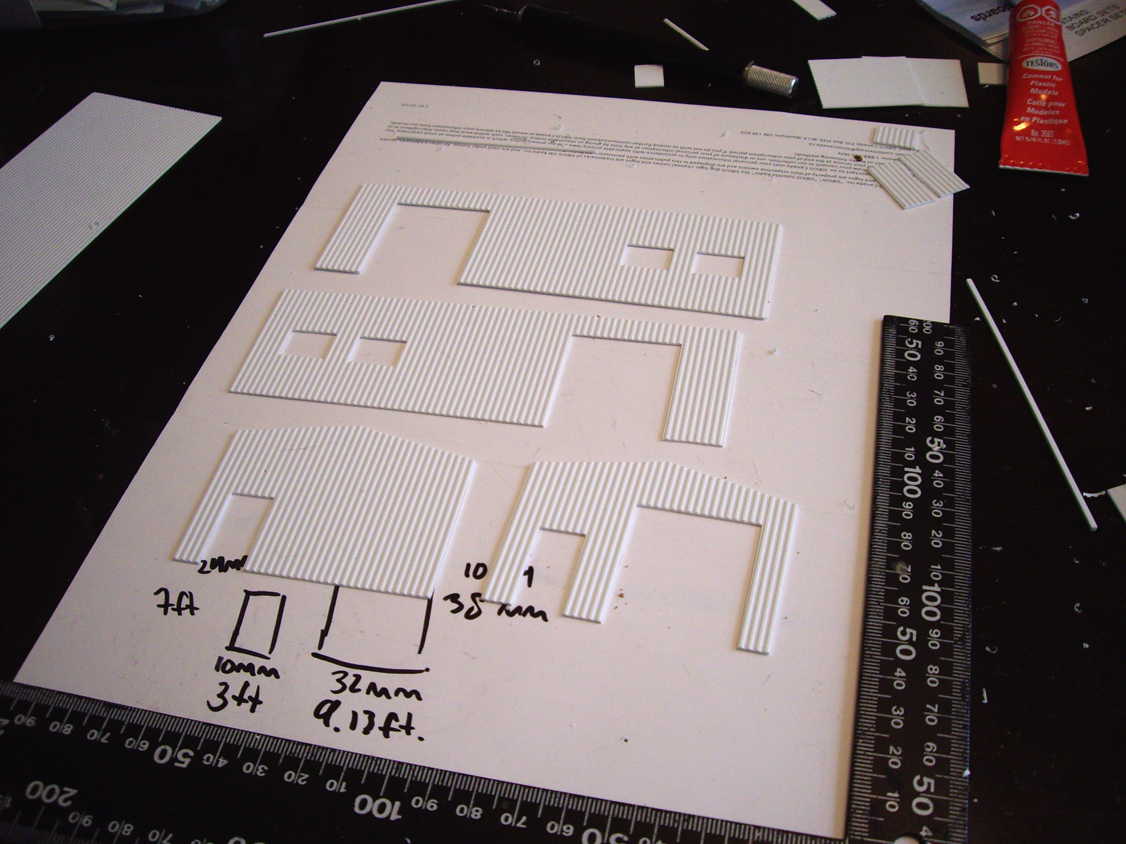I’ve accumulated a small collection of scrap styrene over the last year or
so, mostly from bulk bags of assorted styrene pieces from Evergreen. A
couple of the larger scraps I had consisted of various corrugated patterns,
so I decided to try my hand at building an entirely scratch-built structure.
I decided to keep the design simple for my first attempt. I planned out a
small garage/workshop measuring about 2.5” x 5”. The design includes three
overhead bay doors, four office windows, and two single entrance doors.
There are also two small windows on the front and back. I kept the size of
the building to a minimum as my layout is quite limited for real estate at
this point.
I started by first planning the design of my building on paper, noting the
real-life dimensions of each wall, door, window, and the roof. I then
converted these measurements down to HO scale. Using a new blade, I
carefully marked the measurements on the backside of the styrene sheet and
scored the outline of the wall using a straight edge. I used a square and
ruler to double check the measurements after every score line I made,
ensuring that the walls were kept square and equal. I then gently flexed the
styrene to break each piece apart. I fixed any rough edge with sand paper
and a hobby knife.
The overhead doors were cut from scrap v-groove pattern styrene and the
entry doors from standard smooth styrene. For the main entry door, I cut a
half-length opening for a window and added strip styrene for the insert
trim. I masked the very outside edge of all the doors so I could easily add
glue to these unpainted areas when attaching the doors to the backside of
the walls. The doors were then all sprayed with light aircraft gray
paint.
I hand painted the corrugated steel walls with a mix of blue and steel gray
enamel paint, mixed 1:1 with thinner. After letting the three coats of paint
dry for 24 hours, I glued the overhead and entry doors to the backside of
each wall. I then added trim to the doors using 1.5mm x 1.0mm strip styrene.
I used the same strip styrene for the window frames and on the base of the
building to represent a foundation.
I then glued the four wall pieces together. I added extra styrene support
pieces to the interior for extra rigidity. The roof was a single piece of
v-groove styrene, scored and carefully angled down the center to fit the
slope of the building. After airbrushing the roof a light gray, I carefully
glued it to the main structure. After making a couple touch-ups to the paint
and trim, I weathered the walls, doors, and roof with a variety of powdered
pastels. Lastly, I sealed all the weathering details with two light coats of
dull-coat.
Once the structure was dry, I added clear styrene pieces to the backside of
the walls for window glazing. The final step was to add a black paper
divider and floor to the interior of the so no white plastic could be
visible through the windows. I am quite happy with how this little project
turned out and can’t wait to mix it in with my other model buildings.










2 comments
Looks good! I got some helpful hints from you, thanks.
ReplyDeleteBest Roulette Casino Site - LuckyClub.live
ReplyDeleteRoulette is a popular European Roulette game which was first introduced by the gambling establishment GoldenRace. The luckyclub game can be played on a computer